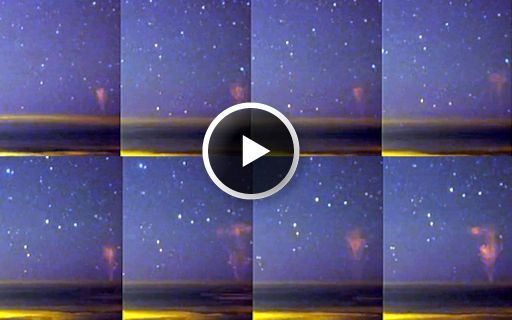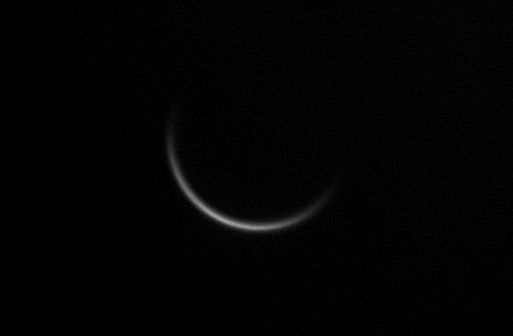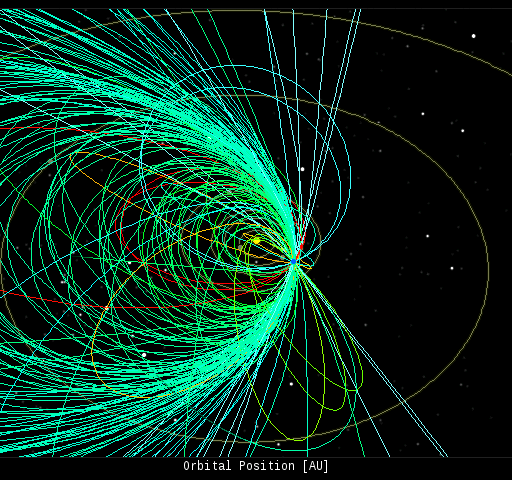Learn to photograph Northern Lights like a pro. Sign up for Peter Rosen's Aurora Photo Courses in Abisko National Park, winner of the TripAdvisor Certificate of Excellence Award 2015. | | |
INCREASING QUIET: Solar activity is returning to very low levels following a brief flurry of minor flares from new sunspot AR2401. As the sunspot's growth has slowed, so has its rate of flare production,and the sun's X-ray output is flatlining again. NOAA forecasters estimate a waning 10% chance of M-class solar flares on August 14th. Solar flare alerts: text or voice
GIGANTIC JETS ABOVE HURRICANE HILDA: Yesterday, we reported a rare apparition of sprites above Hurricane Hilda. Steve Cullen, who lives in Hawaii where the storm is heading, spotted them in video from the Canada-France-Hawaii Telescope CloudCam atop Maunakea. A closer look at the video, however, reveals that the dancing forms were not sprites. Instead, Hurricane Hilda has gigantic jets:

Think of them as sprites on steroids: Gigantic jets are lightning-like discharges that spring from the tops of thunderstorms, reaching all the way from the thunderhead to the ionosphere more than 50 miles overhead. They're enormous and powerful.
"Gigantic jets are much more rare than sprites," says Oscar van der Velde, a member of the Lightning Research Group at the Universitat Politècnica de Catalunya. "While sprites were discovered in 1989 and have since been photographed by the thousands, it was not until 2001-2002 that gigantic jets were first recorded from Puerto Rico and Taiwan." Only a few dozen gigantic jets have ever been seen, mostly over open ocean.
Because gigantic jets are so rare, researchers are paying special attention to Hurricane Hilda. "Observations in recent years suggest that large thunderstorm clusters embedded in tropical cyclones harbor favorable conditions for gigantic jets. Hilda seems to confirm this. Extreme turbulent mixing in the storm top may assist in triggering these events," he says.
Gigantic jets, and their cousins the sprites, reach all the way up to the edge of space alongside meteors, noctilucent clouds, and some auroras. This means they are a true space weather phenomenon. Indeed, some researchers believe cosmic rays help trigger these exotic forms of lightning, but the link is controversial.
Stay tuned for more observations of Hilda's cloudtops as it approaches Hawaii.
Realtime Sprite Photo Gallery
INFERIOR CONJUNCTION OF VENUS: Today and tomorrow, Venus will pass almost-directly between Earth and the sun—an event astronomers call "an inferior conjunction of Venus." The night side of Venus is now facing Earth, with only a sliver of its illuminated dayside visible from our side of the conjunction. Antonios Pantelidis sends this picture, taken August 14th, from Agios Germanos, Greece:

"Only 0.92% of Venus was illuminated," says Pantelidis. "The planet was just less than 8 degrees from the sun."
This is arguably the most beautiful time to observe Venus--but also the most perilous. Even when a telescope is pointed perfectly at Venus, the indirect glare of the nearby sun can damage the eyes of anyone looking through the eyepiece.
Anthony J. Cook of the Griffith Observatory has some advice for observers: "I have observed Venus at conjunction, but only from within the shadow of a building, or by adding a mask to the front end of the telescope to fully shadow the optics from direct sunlight. This is tricky with a refractor or a catadioptric, because the optics start at the front end of the tube. Here at Griffith Observatory, I rotate the telescope dome to make sure the lens of the telescope is shaded from direct sunlight, even through it means that the lens will be partially blocked when aimed at Venus. With our Newtonian telescope, I add a curved cardboard mask at the front end of the tube to shadow the primary mirror."
Potential observers should take precautions as outlined above. That said, if you have a GOTO telescope, command it to slew to Venus this evening. The crescent is marvelous.
Realtime Venus Photo Gallery
Realtime Space Weather Photo Gallery
Realtime Aurora Photo Gallery
Realtime NLC Photo Gallery
Every night, a network of NASA all-sky cameras scans the skies above the United States for meteoritic fireballs. Automated software maintained by NASA's Meteoroid Environment Office calculates their orbits, velocity, penetration depth in Earth's atmosphere and many other characteristics. Daily results are presented here on Spaceweather.com.
On Aug. 14, 2015, the network reported 163 fireballs.
(82 Perseids, 75 sporadics, 2 Southern delta Aquariids, 1 Northern delta Aquariid, 1 kappa Cygnid, 1 , 1)

In this diagram of the inner solar system, all of the fireball orbits intersect at a single point--Earth. The orbits are color-coded by velocity, from slow (red) to fast (blue). [Larger image] [movies]
Potentially Hazardous Asteroids (
PHAs) are space rocks larger than approximately 100m that can come closer to Earth than 0.05 AU. None of the known PHAs is on a collision course with our planet, although astronomers are finding
new ones all the time.
On August 14, 2015 there were potentially hazardous asteroids.
Notes: LD means "Lunar Distance." 1 LD = 384,401 km, the distance between Earth and the Moon. 1 LD also equals 0.00256 AU. MAG is the visual magnitude of the asteroid on the date of closest approach. | | The official U.S. government space weather bureau |
| | The first place to look for information about sundogs, pillars, rainbows and related phenomena. |
| | Researchers call it a "Hubble for the sun." SDO is the most advanced solar observatory ever. |
| | 3D views of the sun from NASA's Solar and Terrestrial Relations Observatory |
| | Realtime and archival images of the Sun from SOHO. |
| | from the NOAA Space Environment Center |
| | the underlying science of space weather |
| | Web-based high school science course with free enrollment |

